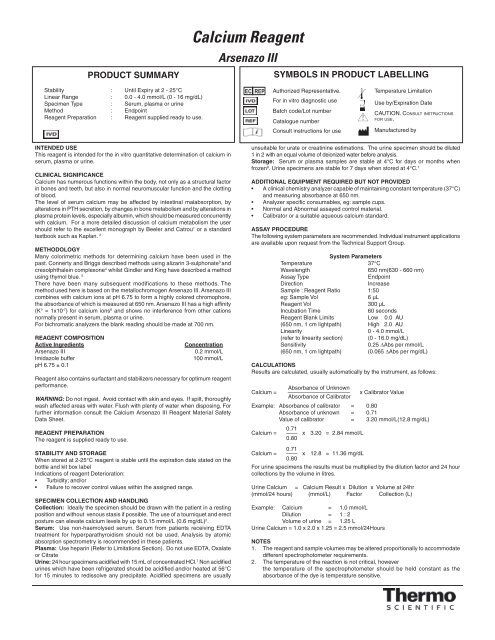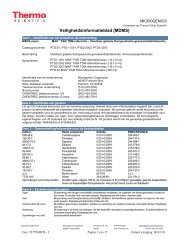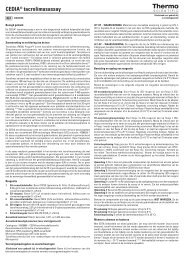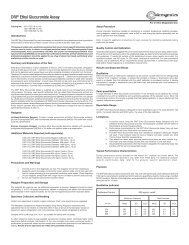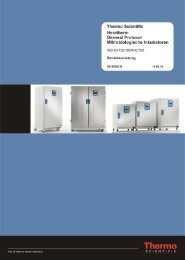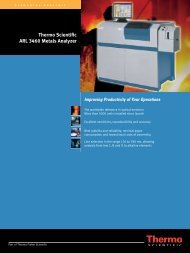Calcium Reagent - Fisher Scientific
Calcium Reagent - Fisher Scientific
Calcium Reagent - Fisher Scientific
You also want an ePaper? Increase the reach of your titles
YUMPU automatically turns print PDFs into web optimized ePapers that Google loves.
PRODUCT SUMMARY<br />
Stability : Until Expiry at 2 - 25°C<br />
Linear Range : 0.0 - 4.0 mmol/L (0 - 16 mg/dL)<br />
Specimen Type : Serum, plasma or urine<br />
Method : Endpoint<br />
<strong>Reagent</strong> Preparation : <strong>Reagent</strong> supplied ready to use.<br />
INTENDED USE<br />
This reagent is intended for the in vitro quantitative determination of calcium in<br />
serum, plasma or urine.<br />
CLINICAL SIGNIFICANCE<br />
<strong>Calcium</strong> has numerous functions within the body, not only as a structural factor<br />
in bones and teeth, but also in normal neuromuscular function and the clotting<br />
of blood.<br />
The level of serum calcium may be affected by intestinal malabsorption, by<br />
alterations in PTH secretion, by changes in bone metabolism and by alterations in<br />
plasma protein levels, especially albumin, which should be measured concurrently<br />
with calcium. For a more detailed discussion of calcium metabolism the user<br />
should refer to the excellent monograph by Beeler and Catrou 1 or a standard<br />
textbook such as Kaplan. 2<br />
METHODOLOGY<br />
Many colorimetric methods for determining calcium have been used in the<br />
past. Connerty and Briggs described methods using alizarin 3-sulphonate 3 and<br />
cresolphthalein complexone 4 whilst Gindler and King have described a method<br />
using thymol blue. 5<br />
There have been many subsequent modifications to these methods. The<br />
method used here is based on the metallochromogen Arsenazo III. Arsenazo III<br />
combines with calcium ions at pH 6.75 to form a highly colored chromophore,<br />
the absorbance of which is measured at 650 nm. Arsenazo III has a high affi nity<br />
(K° = 1x10 -7 ) for calcium ions 6 and shows no interference from other cations<br />
normally present in serum, plasma or urine.<br />
For bichromatic analyzers the blank reading should be made at 700 nm.<br />
REAGENT COMPOSITION<br />
Active Ingredients Concentration<br />
Arsenazo III 0.2 mmol/L<br />
Imidazole buffer 100 mmol/L<br />
pH 6.75 ± 0.1<br />
<strong>Reagent</strong> also contains surfactant and stabilizers necessary for optimum reagent<br />
performance.<br />
WARNING: Do not ingest. Avoid contact with skin and eyes. If spilt, thoroughly<br />
wash affected areas with water. Flush with plenty of water when disposing. For<br />
further information consult the <strong>Calcium</strong> Arsenazo III <strong>Reagent</strong> Material Safety<br />
Data Sheet.<br />
REAGENT PREPARATION<br />
The reagent is supplied ready to use.<br />
STABILITY AND STORAGE<br />
When stored at 2-25°C reagent is stable until the expiration date stated on the<br />
bottle and kit box label<br />
Indications of reagent Deterioration:<br />
Turbidity; and/or<br />
Failure to recover control values within the assigned range.<br />
SPECIMEN COLLECTION AND HANDLING<br />
Collection: Ideally the specimen should be drawn with the patient in a resting<br />
position and without venous stasis if possible. The use of a tourniquet and erect<br />
posture can elevate calcium levels by up to 0.15 mmol/L (0.6 mg/dL) 2 .<br />
Serum: Use non-haemolysed serum. Serum from patients receiving EDTA<br />
treatment for hyperparathyroidism should not be used. Analysis by atomic<br />
absorption spectrometry is recommended in these patients.<br />
Plasma: Use heparin (Refer to Limitations Section). Do not use EDTA, Oxalate<br />
or Citrate<br />
Urine: 24 hour specimens acidifi ed with 15 mL of concentrated HCl. 7 Non acidifi ed<br />
urines which have been refrigerated should be acidifi ed and/or heated at 56°C<br />
for 15 minutes to redissolve any precipitate. Acidifi ed specimens are usually<br />
<strong>Calcium</strong> <strong>Reagent</strong><br />
Arsenazo III<br />
EC REP<br />
SYMBOLS IN PRODUCT LABELLING<br />
Authorized Representative.<br />
For in vitro diagnostic use<br />
Batch code/Lot number<br />
Catalogue number<br />
Consult instructions for use<br />
unsuitable for urate or creatinine estimations. The urine specimen should be diluted<br />
1 in 2 with an equal volume of deionized water before analysis.<br />
Storage: Serum or plasma samples are stable at 4°C for days or months when<br />
frozen 8 . Urine specimens are stable for 7 days when stored at 4°C. 7<br />
ADDITIONAL EQUIPMENT REQUIRED BUT NOT PROVIDED<br />
A clinical chemistry analyzer capable of maintaining constant temperature (37°C)<br />
and measuring absorbance at 650 nm.<br />
Analyzer specifi c consumables, eg: sample cups.<br />
Normal and Abnormal assayed control material.<br />
Calibrator or a suitable aqueous calcium standard.<br />
ASSAY PROCEDURE<br />
The following system parameters are recommended. Individual instrument applications<br />
are available upon request from the Technical Support Group.<br />
System Parameters<br />
Temperature 37°C<br />
Wavelength 650 nm(630 - 660 nm)<br />
Assay Type Endpoint<br />
Direction Increase<br />
Sample : <strong>Reagent</strong> Ratio 1:50<br />
eg: Sample Vol 6 µL<br />
<strong>Reagent</strong> Vol 300 µL<br />
Incubation Time 60 seconds<br />
<strong>Reagent</strong> Blank Limits Low 0.0 AU<br />
(650 nm, 1 cm lightpath) High 2.0 AU<br />
Linearity 0 - 4.0 mmol/L<br />
(refer to linearity section) (0 - 16.0 mg/dL)<br />
Sensitivity 0.25 ΔAbs per mmol/L<br />
(650 nm, 1 cm lightpath) (0.065 ΔAbs per mg/dL)<br />
CALCULATIONS<br />
Results are calculated, usually automatically by the instrument, as follows:<br />
<strong>Calcium</strong> =<br />
Absorbance of Unknown<br />
———————————<br />
Absorbance of Calibrator<br />
x Calibrator Value<br />
Example: Absorbance of calibrator = 0.80<br />
Absorbance of unknown = 0.71<br />
Value of calibrator = 3.20 mmol/L(12.8 mg/dL)<br />
0.71<br />
<strong>Calcium</strong> = —— x 3.20 = 2.84 mmol/L<br />
0.80<br />
0.71<br />
<strong>Calcium</strong> = —— x 12.8 = 11.36 mg/dL<br />
0.80<br />
For urine specimens the results must be multiplied by the dilution factor and 24 hour<br />
collections by the volume in litres.<br />
Urine <strong>Calcium</strong> = <strong>Calcium</strong> Result x Dilution x Volume at 24hr<br />
(mmol/24 hours) (mmol/L) Factor Collection (L)<br />
Example: <strong>Calcium</strong> = 1.0 mmol/L<br />
Dilution = 1 : 2<br />
Volume of urine = 1.25 L<br />
Urine <strong>Calcium</strong> = 1.0 x 2.0 x 1.25 = 2.5 mmol/24Hours<br />
Temperature Limitation<br />
Use by/Expiration Date<br />
CAUTION. CONSULT INSTRUCTIONS<br />
FOR USE.<br />
Manufactured by<br />
NOTES<br />
1. The reagent and sample volumes may be altered proportionally to accommodate<br />
different spectrophotometer requirements.<br />
2. The temperature of the reaction is not critical, however<br />
the temperature of the spectrophotometer should be held constant as the<br />
absorbance of the dye is temperature sensitive.
3. The color developed is stable for at least 2 hours.<br />
4. Because of the need to obtain highly accurate calcium results, it is<br />
recommended that the manual assay should be performed in duplicate.<br />
5. S.I. conversion factor: mmol/L x 4 = mg/dL.<br />
CALIBRATION<br />
Calibration is required. An aqueous standard or serum based calibrator, with<br />
and assigned value traceable to a primary standard (eg NIST or IRMM) is<br />
recommended. For calibration frequency on automated instruments refer to<br />
the instrument manufacturers specifi cations. However, calibration stability is<br />
contingent upon optimum instrument performance and the use of reagents<br />
which have been stored as recommended in the stability and storage section<br />
of this package insert. Recalibration is recommended at anytime if one of the<br />
following events occurs:-<br />
The Lot number of reagent changes.<br />
Preventative maintenance is performed or a critical component is<br />
replaced.<br />
Control values have shifted or are out of range and a new vial of control<br />
does not rectify the problem.<br />
QUALITY CONTROL<br />
To ensure adequate quality control, normal and abnormal control with assayed<br />
values should be run as unknown samples:-<br />
At least every eight hours or as established by the laboratory.<br />
When a new bottle of reagent is used.<br />
After preventative maintenance is performed or a critical component is<br />
replaced.<br />
Control results falling outside the established limits indicate the assay may be<br />
out of control.<br />
The following corrective actions are recommended in such situations:-<br />
Repeat the same controls.<br />
If repeated control results are outside the limits, prepare fresh control serum<br />
and repeat the test.<br />
If results are still out of control, recalibrate with fresh calibrator, then repeat<br />
the test.<br />
If results are still out of control, perform a calibration with fresh reagent, then<br />
repeat the test.<br />
If results remain out of control, contact Technical Services or your local<br />
distributor.<br />
LIMITATIONS<br />
1. Care must be taken to avoid calcium contamination. The use of disposable<br />
plastic tubes or cuvettes is strongly recommended. The user should assure<br />
themselves that such disposables are free from calcium contamination. If<br />
glassware is used, it should be soaked in dilute HCl or a strong laboratory<br />
cleanser and thoroughly rinsed with distilled or deionized water.<br />
2. Gross haemolysis and lipaemia may cause falsely elevated results unless<br />
a sample blank is used.<br />
3. Grossly elevated citrate levels may cause falsely low results.<br />
4. If bichromatic analysis is available it is recommended that plasma samples<br />
be run using a bichromatic wavelength of 700 nm.<br />
5. Copper may interfere with this method. 9 Therefore, care should be taken<br />
to avoid contamination with reagents that contain high concentrations of<br />
copper such as Biuret reagent (Total Protein reagent).<br />
6. For a more comprehensive review of factors affecting calcium assays refer<br />
to the publications of Young, et al. 10 and Friedman, et al. 11<br />
7. Studies to determine the level of interference from haemoglobin, bilirubin<br />
and lipaemia were carried out. The following results were obtained:<br />
Haemoglobin: No interference from haemoglobin up to 540 mg/dL.<br />
Bilirubin: No interference from bilirubin up to 340 µmol/L (20 mg/dL).<br />
Lipaemia: No interference from lipaemia, measured as triglycerides up to<br />
20.2 mmol/L (1770 mg/dL).<br />
EXPECTED VALUES<br />
It is generally agreed that with current methods for serum calcium the reference<br />
range is approximately 2.10-2.55 mmol/L (8.4-10.2 mg/dL) with a mean value<br />
of approximately 2.30-2.40 mmol/L (9.3 mg/dL). 2,12 This is somewhat lower than<br />
older published normal ranges.<br />
As the reference range depends to some extent on collection techniques and<br />
laboratory procedures, the user should verify the reference range in their own<br />
laboratory. For 24 hour urine specimens with patients on a normal diet, the<br />
reference range is 2.5-7.5 mmol/day (100-300 mg/day). 12<br />
PERFORMANCE DATA<br />
The following data was obtained with the <strong>Calcium</strong> <strong>Reagent</strong> on an automated<br />
clinical chemistry analyzer. Users should establish product performance on the<br />
specifi c analyzer used.<br />
<strong>Fisher</strong> Diagnostics<br />
a division of <strong>Fisher</strong> Scientifi c Company, LLC<br />
a part of Thermo <strong>Fisher</strong> Scientifi c Inc.<br />
Middletown, VA 22645-1905 USA<br />
Phone: 800-528-0494<br />
540-869-3200<br />
Fax: 540-869-8132<br />
840298 (R3)<br />
IMPRECISION<br />
Imprecision was evaluated using two levels of commercial controls and following the<br />
NCCLS EP5-T procedure. 13<br />
SERUM<br />
Within Run LEVEL I LEVEL II<br />
Number of data points 80 80<br />
Mean 1.45 mmol/L (5.8 mg/dL) 2.85 mmol/L (11.4 mg/dL)<br />
SD 0.03 mmol/L (0.11 mg/dL) 0.04 mmol/L (0.16 mg/dL)<br />
CV (%) 1.8 1.4<br />
Total LEVEL I LEVEL II<br />
Number of data points 80 80<br />
Mean 1.45 mmol/L (5.8 mg/dL) 2.85 mmol/L (11.4 mg/dL)<br />
SD 0.05 mmol/L (0.2 mg/dL) 0.07 mmol/L (0.28 mg/dL)<br />
CV (%) 3.5 2.4<br />
The following precision data was obtained for urine samples:<br />
URINE<br />
Within Run LEVEL I LEVEL II<br />
Number of data points 20 20<br />
Mean 1.01 mmol/L (4.0 mg/dL) 3.84 mmol/L (15.4 mg/dL)<br />
SD 0.01 mmol/L (0.04 mg/dL) 0.07mmol/L (0.28 mg/dL)<br />
CV (%) 1.5 1.7<br />
Between Run LEVEL I LEVEL II<br />
Number of data points 16 16<br />
Mean 1.10 mmol/L(4.4 mg/dL) 3.84 mmol/L (15.4 mg/dL)<br />
SD 0.04 mmol/L (0.16 mg/dL) 0.10 mmol/L (0.40 mg/dL)<br />
CV (%) 3.2 2.6<br />
ACCURACY<br />
Comparison studies were done using another commercially available colorimetric<br />
calcium reagent. Normal and abnormal patient serum, plasma and urine samples<br />
were assayed in parallel. The results were compared by least squares regression<br />
and the following statistics were obtained:<br />
Plasma/Serum Urine<br />
Number of Pairs 70 15<br />
Range of Results (mmol/L) 1.20-4.08 0.86-7.92<br />
Range of Results (mg/L) 4.8-16.3 3.4-31.7<br />
Reference Method (mmol/L) 2.45 3.52<br />
Reference Method (mg/dL) 9.8 14.1<br />
<strong>Calcium</strong> Results (mmol/L) 2.47 3.53<br />
<strong>Calcium</strong> Results (mg/dL) 9.9 14.1<br />
Slope 0.99 1.02<br />
Intercept 0.05 -0.05<br />
Correlation Coeffi cient 0.99 0.99<br />
LINEARITY<br />
When run as recommended the assay is linear to 4.0 mmol/L (16.0 mg/dL).<br />
SENSITIVITY<br />
When run as recommended the sensitivity of the assay is 0.26 ΔA per mmol/L (0.065<br />
ΔA per mg/dL).<br />
REFERENCES<br />
1. Beeler MF and Catrou PG. “Disorders of <strong>Calcium</strong> Metabolism” in Interpretations<br />
in Clinical Chemistry A.C.S.P. Press Chicago 1983; 34-44.<br />
2. Farrell CE. “Electrolytes” in Clinical Chemistry Theory, Analysis and Correlation.<br />
The CV Mosby Company. Kaplan LA, Pesce AJ (Ed). 1984; Chap 55:1054.<br />
3. Connerty HV, Briggs AR. Clin Chem1965;11:716-28.<br />
4. Connerty HV, Briggs AR. Am J Clin Path 1966;45:290-6.<br />
5. Gindler EM, Kin JD. Am J. Clin Path 1972;58:376-82.<br />
6. Bauer PJ. Anal Biochem 1981;110:61-72.<br />
7. Shephard MD, Mezzachi RD.Clin Biochem Revs 1983;4:61-7.<br />
8. Tietz Textbook of Clinical Chemistry, W.B. Saunders Co. Second Edition<br />
1994:1893.<br />
9. Janssen JW and Helbing AR. Eur J Clin Chem Clin Biochem 1991;29:197-201.<br />
10. Young DS, et al. Clin Chem 1975;21:272D-4D.<br />
11. Friedman RB et al. Clin Chem 1980;26:61D-4D.<br />
12. Tietz Textbook of Clinical Chemistry, W.B. Saunders Co. Second Edition<br />
1994:2180.<br />
13. National Committee of Clinical Laboratory Standards. User evaluation of Precision<br />
Performance of Clinical Chemistry Devices NCCLS 1984; NCCLS publication<br />
EP5-T.<br />
© 2010 Thermo <strong>Fisher</strong> Scientifi c Inc. All rights reserved.<br />
Reorder Information<br />
Catalogue No. Confi guration<br />
TR29226 2 x 250 mL


